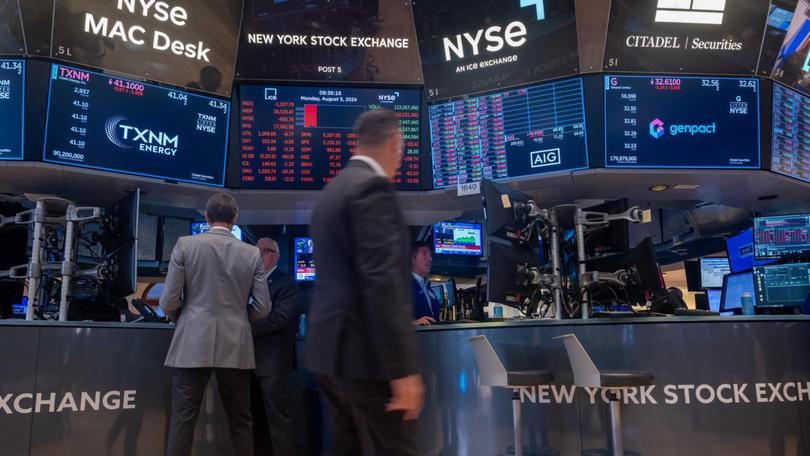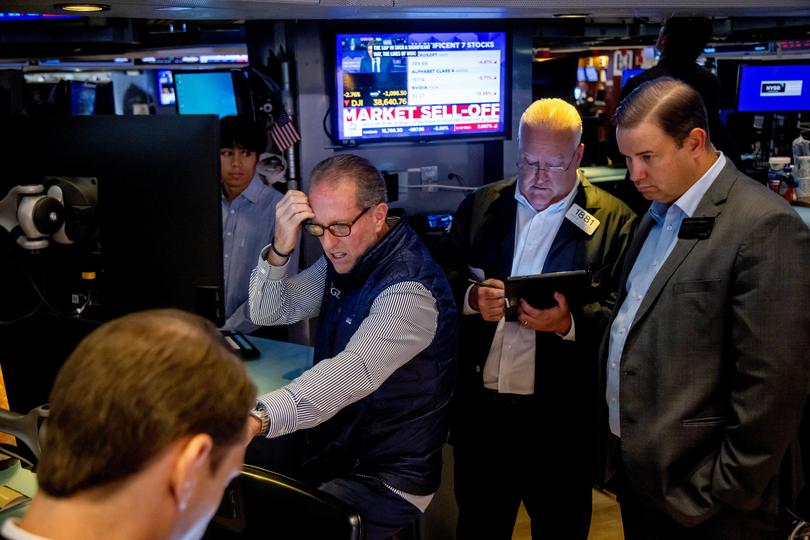The Economist: The stock market rout may not be over

For a while on August 5, things were looking awful. During the Asian trading session, Japan’s benchmark Topix share index had fallen by 12 per cent, marking its worst day since 1987.
Stock prices in South Korea and Taiwan had tanked by 9 per cent and 8 per cent respectively, and European markets were falling.
Before trading began in America, the VIX index, which measures how wildly traders expect share prices to swing, was at a level it had only reached early in the COVID-19 pandemic and after Lehman Brothers collapsed in 2008.
Sign up to The Nightly's newsletters.
Get the first look at the digital newspaper, curated daily stories and breaking headlines delivered to your inbox.
By continuing you agree to our Terms and Privacy Policy.Ominously, though gold is usually a hedge against chaos, its price was falling — suggesting that investors might be selling assets they would rather hold on to in order to stay afloat.
The previous week’s rout in global markets seemed to be spiralling into a full-blown crisis.
Mercifully, the panic started to ebb once Wall Street opened for business. The VIX fell back to only its highest during the crash of 2022; by the end of the day, the S&P 500 index of large American firms was down by a painful, but not catastrophic, 3 per cent.
On August 6 European markets were fairly flat and Asian ones staged a blistering recovery, especially in Japan, where the Topix rose by 9 per cent. Half an hour after the opening bell had rung in New York, the S&P 500 was up by 1 per cent.
Traders may be able to pause for breath and a few hours’ sleep. Even as they do so, however, one question looms large. Did markets simply succumb to a brief bout of summer madness, or is the worst still to come?
One clue to the answer is that what began as the unwinding of a few popular trades has now spread.
The early stages of the fall, which began in mid-July, were led by Japanese stocks, American big-tech firms and global companies in the chipmaking supply chain. They were triggered by a rapidly strengthening yen in the first case and evaporating euphoria over artificial intelligence (AI) in the next two.
On August 2 an unexpectedly weak American jobs report accelerated the plunge dramatically by suggesting that the world’s biggest economy may be closer to recession than most had thought.
That still left room for a fair few winners. Even as America’s headline indices sank, shares in companies such as Johnson & Johnson, Procter & Gamble and UnitedHealth enjoyed a bounce on the day of the jobs report. Such firms are in sectors well-placed to weather a downturn (pharma, consumer staples and health care, respectively), and pay healthy dividends, raising their value as the Federal Reserve becomes more likely to cut interest rates.
But by August 5 that was little help. Investors were ditching them alongside virtually every other stock in the S&P 500.
Such indiscriminate selling may well resume. Christian Raute, a trading-strategy boss at Citigroup, a bank, says that the breadth of the selling suggests that professional investors have received a “tap on the shoulder” from above, ordering them to reduce their risk no matter what they need to offload to do so. For large funds, that will take more than just a few days of sales.

In the meantime, other outfits will hesitate to buy even assets they think have become underpriced, fearing a behemoth somewhere still has a big position to dump into the market. The gut-churning drops, in other words, may be far from over.
Investors may be forced out of especially crowded bets for other reasons. Look at the astonishing speed with which the Japanese yen has strengthened in recent weeks, for instance, which is probably because of the unravelling of “carry trades”. These involve borrowing yen cheaply and using the proceeds to buy other assets — perhaps a higher-yielding currency, such as the American dollar or Mexican peso, or even stocks.
But should the yen suddenly strengthen relative to the other asset, the trade quickly plunges into the red and may need to be terminated. Doing so involves selling the other asset and buying yen to pay back the debt, exacerbating the move and quite possibly forcing others into the same position, creating a vicious circle. If this generates a big loss, the investor may also need to exit other positions to meet it.
Some of the violent recent swings in the yen, Japanese and American stocks, and indeed the Mexican peso may thus be down to yen-based carry trades. Moreover, any popular trade that some investors have funded through borrowing can fall victim to the same sort of doom loop. Bets on firms linked to AI euphoria are a prime candidate.
The VIX index’s hair-raising spike on August 5, caused by hordes of investors clamouring to buy insurance on the same stocks at once, suggests quite how crowded such positions are even after the recent unwinding. It also shows quite how much this crowding can move markets. And so there is plenty of potential for future sales, whether forced or voluntary, to cause further ructions.
The most dangerous escalation would come if the turbulence left a sizeable investment vehicle unable to raise the cash to meet margin calls or close loss-making positions. That is what happened to Archegos, a family office, in 2021, prompting fire-sales of its assets and losses for its banks stretching into the billions. At a bigger outfit, such a collapse could spread contagion across the market and imperil other firms.
As yet, “there is not sufficient pain to suggest a big player is in danger,” says Citi’s Mr Raute. “But if we see five more days of this, that may change.”
Another cause for panic could come from bad news on the economy, or on the viability of the AI boom.
There are plenty of potential flashpoints before the summer is out. Around a quarter of firms in the S&P 500 are still due to report their second-quarter earnings. These include Home Depot and Walmart, barometers of American consumer sentiment, and Nvidia, on which the fortunes of AI investors everywhere depend. Inflation data released on August 14 will hint at whether the Fed can indeed cut rates by 0.5 percentage points in September, which many are convinced it must in order to stave off a recession. Given the carnage that followed the most recent jobs report, the next, on September 6th, is another obvious catalyst.
Even now America’s stockmarket remains more expensive relative to firms’ underlying earnings than at almost any point in history. Greed has given way to fear, and the bulls have taken a battering. But if valuations are to return to normality, there is still a long way to go.
